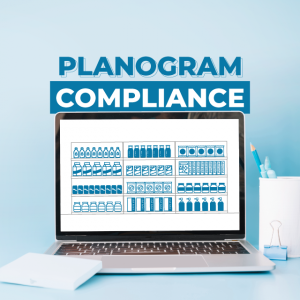Planogram Compliance: A Significant Increase in Revenue
A planogram is a diagram that directs how shelves and store displays should look and how products should be placed. To ensure their product stands out, brands and retailers invest much time and money into developing modern retail execution and product placement strategies to increase sales and boost profitability.
Planograms are crucial retail management tools, but building one is only half the battle; checking that planograms are correctly executed is just as important.

What is Planogram Compliance?
Planogram compliance is a retailer’s fidelity and adherence to a brand’s provided planogram. Correct planogram compliance ensures that the installation and position of products are in order, maximizing sales through efficient visual merchandising.
However, planogram compliance can be challenging to monitor, and brands often lack the visibility to know if those programs are executed correctly. Research shows that only about 40% of retailers can measure compliance, and most product categories are less than 50% compliant with planograms, leading to poor retail execution.
Maintaining planogram compliance in numerous retail stores is an ongoing challenge for companies that can lead to skewed results and inaccurate data.

The Importance of Planogram Compliance
Without compliance, retailers cannot accurately measure the effectiveness of their planograms. According to the National Association of Retail Marketing Services, achieving correct planogram compliance leads to an 8.1% lift in profit.
Effective planograms improve customer satisfaction, vendor terms and conditions, and on-shelf availability. In addition, they ensure the correct stock levels and that SKUs are well-displayed at the planned locations and displayed next to the proper merchandising.
Reduces OOS situations: Planograms provide a visual representation of how merchandise should look on the shelf. Field teams can use them as a guide to quickly identify stock scarcity, effectively manage inventory, and optimize re-stocking.
Improves in-store customer experience: Planogram compliance allows for a better customer experience, making it easier for shoppers to find products and increasing sell-through.
Monitor Planogram Compliance with Crowdsourcing
Employees and management often find it challenging to comply with planograms at the store level, with a weekly drop-off rate of over 10%.
Why is it so often neglected because planogram compliance is so crucial for brands and retailers? The primary reason is that a traditional field-marketing approach is usually too slow and expensive to sustain over time.
That said, monitoring planogram compliance through crowdsourced retail audits is the most cost-effective strategy for your business, as it offers retailers timely, location-based data at a sustainable cost.
By crowdsourcing, you leverage a network of mobile users spread across Australia, always ready anywhere in the country. They provide all insights required when an assignment is close to their location, collecting real-time data.
Every detail counts: attractive shelves with neatly faced products, compliance with planograms, and share-of-shelf per SKU or brand. SmartSpotter’s robust, innovative mobile application collects real-time information, allowing you to target your actions to ensure retailer-supplier agreements are maximized, and planograms are executed as needed.
